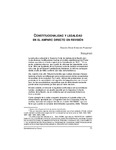| dc.contributor.author | Góngora Pimentel, Genaro David | |
| dc.creator | GONGORA PIMENTEL, GENARO DAVID; 347356 | |
| dc.date.accessioned | 2018-05-03T20:15:13Z | |
| dc.date.available | 2018-05-03T20:15:13Z | |
| dc.date.issued | 2006-07 | |
| dc.identifier.citation | Góngora Pimentel, G. D. (2006). Constitucionalidad y legalidad en el amparo directo en revisión. Revista Académica de la Facultad de Derecho de la Universidad La Salle, 4(7), 71-104. | es_MX |
| dc.identifier.issn | 1665-8639 | |
| dc.identifier.uri | http://repositorio.lasalle.mx/handle/lasalle/348 | |
| dc.description.abstract | La estructura actual de la Suprema Corte de Justicia de la Nación deriva de diversas modificaciones hechas al modelo constitucional del Poder Judicial previsto en el texto original de la Constitución de 1917.1 Al respecto, podemos observar que a partir de reformas tan importantes como la de 1994, las facultades de la Suprema Corte de Justicia corresponden más a las de un Tribunal Constitucional. Asimismo, la reforma correspondiente al año de 1999, confirmó aún más dicha tendencia. Así, nuestro más alto Tribunal ha tenido que realizar diversas interpretaciones al texto constitucional como consecuencia de las necesidades imperantes de la sociedad. Por tanto, dichas interpretaciones no son producto de la casualidad o del capricho del juzgador, sino son el resultado de las características específicas que en determinado momento puede tener un problema jurídico que se debe resolver. En este sentido, el tema de la legalidad confrontada con la constitucionalidad analizada en un asunto resuelto por la Suprema Corte de Justicia de la Nación, es un problema que en ocasiones todavía se hace presente. Como ejemplo de lo antes expuesto, tenemos el reciente criterio de interpretación aprobado por la Segunda Sala de la Suprema Corte de Justicia, derivado del amparo directo en revisión 1994/2005,2 que sostiene que cuando se cumplan determinados supuestos, dicho Tribunal puede pronunciarse sobre aspectos de legalidad. Dada la trascendencia que podría llegar a tener el citado criterio, el mismo será materia de análisis en el presente trabajo. Primero mencionaremos diversos aspectos de la reforma de 1999, las características generales del Acuerdo 5/1999 y su relación con el tema del amparo directo en revisión. Luego, se mencionarán algunos criterios de interpretación sobresalientes en la materia de amparo directo en revisión conocido por la Suprema Corte de Justicia. Posteriormente, se expondrán las características generales del amparo directo en revisión 1994/2005, así como los argumentos expuestos en el estudio de los agravios del recurso y los elementos que se advierten de la tesis IV/2006. Finalmente, se relacionarán los preceptos legales, los criterios de interpretación, las características del amparo directo en revisión 1994/2005 y la tesis IV/2006. Esto, con el objeto de delimitar los alcances y efectos de la tesis de referencia. | es_MX |
| dc.description.abstract | The structure of the Supreme Court of Justice of the Nation nowadays, is the result of several amendments to the original form of the Judicial Branch as stated in the Mexican Constitution.3 On the subject, we can observe that since the important amendment of 1994, the faculties of the Supreme Court of Justice are more likely a Constitutional Court. In the same way, the amendment of 1999, confirmed the same tendency. Thus, our Highest Court has performed several legal interpretations to the text of the Constitution according to the needs of the society. Therefore, such interpretations are not merely coincidence nor the judge's caprice, but the result of specific characteristics that in certain moment may present a legal problem that must be solved. In the same way, the theme of legality against the constitution as analyzed in an issue solved by the Supreme Court of Justice of the Nation is a problem that still exists. As an example of the before mentioned, we find the recent opinion of interpretation approved by the Second Hall of the Supreme Court of Justice, from the judicial revision in direct amparo 1994/2005,4 which states that when some circumstances appear, such Court may declare over aspects of legality. Because of the importance of such opinion, the same will be analyzed in this work. First, we will mention some aspects of the amendment of 1999, the general characteristics of the Agreement 5/1999 and its relation to the theme of judicial review in direct amparo. Then, some of the outstanding criteria over interpretation regarding judicial review in direct amparo known by the Supreme Court of Justice will be mentioned. Afterwards, the general characteristics of the judicial review in direct amparo 1994/2005 will be exposed, as well as the arguments referred in the study of the arguments of the remedy and the elements of the thesis IV/2006. Finally, the legal statements, the interpretation criteria, the characteristics of judicial review in direct amparo 1994/2005 and the thesis IV/2006 will be linked. This, in order to define the reaches and effects of the mentioned thesis. | es_MX |
| dc.format | application/pdf | es_MX |
| dc.language.iso | spa | es_MX |
| dc.publisher | Universidad La Salle, Facultad de Derecho | es_MX |
| dc.rights | Acceso abierto | es_MX |
| dc.rights.uri | http://creativecommons.org/licenses/by-nc-nd/4.0 | * |
| dc.subject | Constitución Política de los Estados Unidos Mexicanos | es_MX |
| dc.subject | Legalidad | es_MX |
| dc.subject | Amparo | es_MX |
| dc.subject | Suprema Corte de la Justicia de la Nación | es_MX |
| dc.subject.classification | CIENCIAS SOCIALES::CIENCIAS JURÍDICAS Y DERECHO::DERECHO Y LEGISLACIÓN NACIONALES::DERECHO CONSTITUCIONAL | es_MX |
| dc.subject.other | Derecho | es_MX |
| dc.title | Constitucionalidad y legalidad en el amparo directo en revisión | es_MX |
| dc.type | article | es_MX |
| dc.audience | generalPublic | es_MX |







